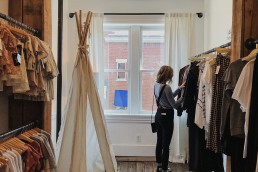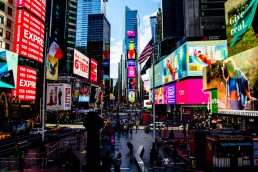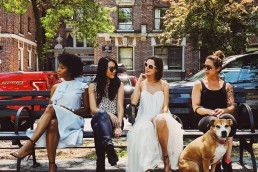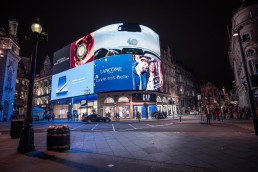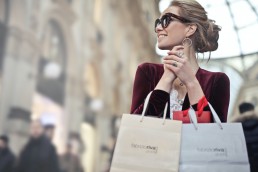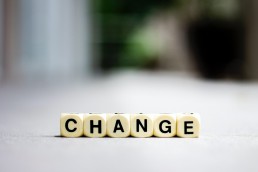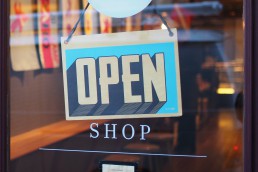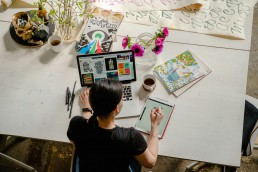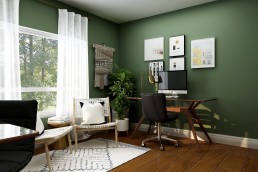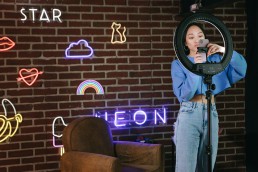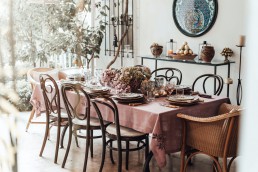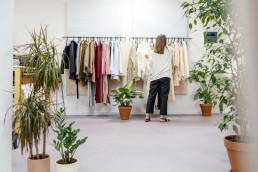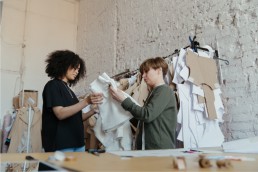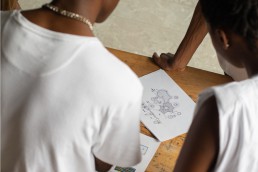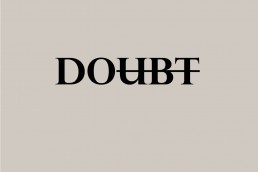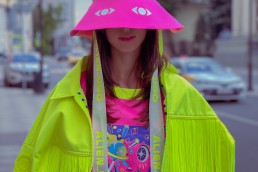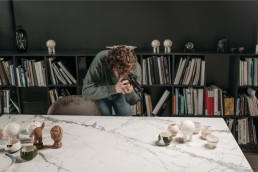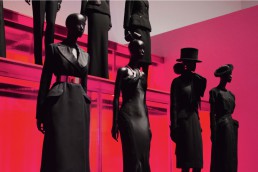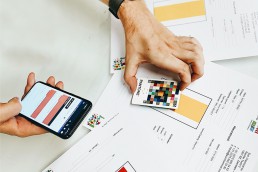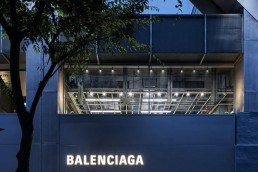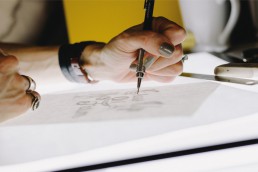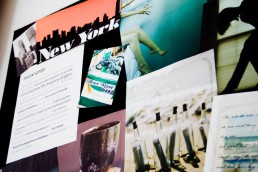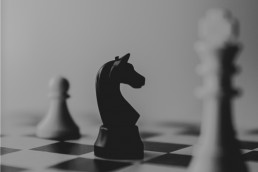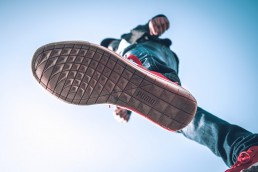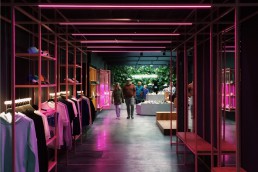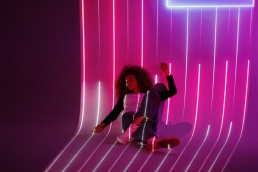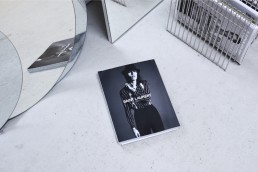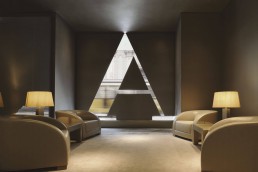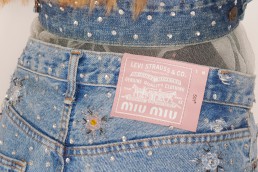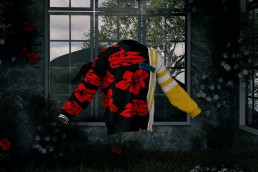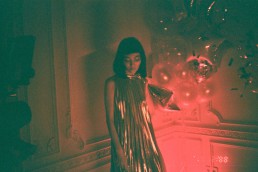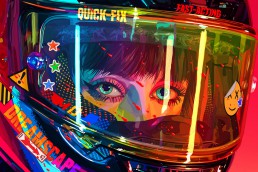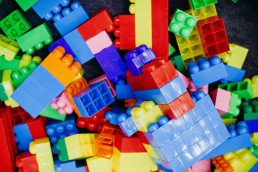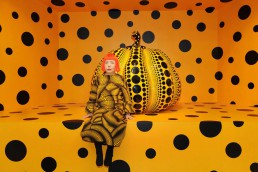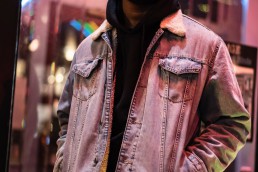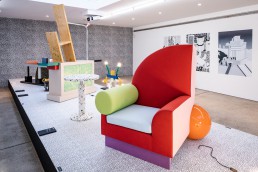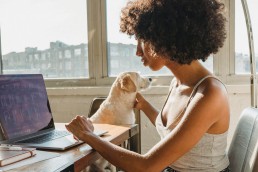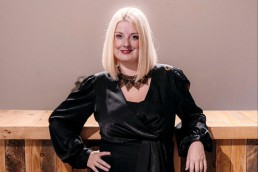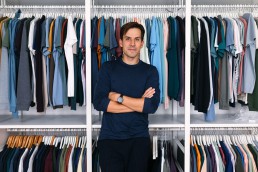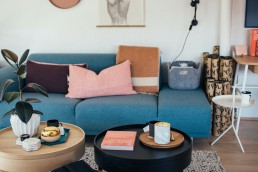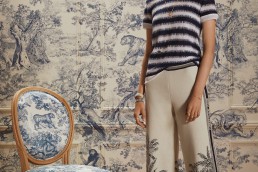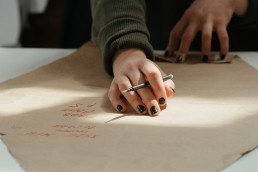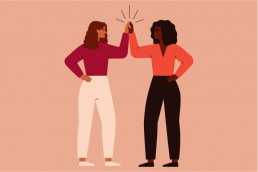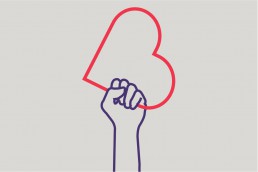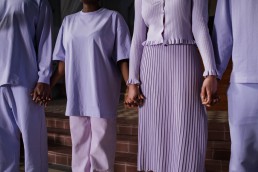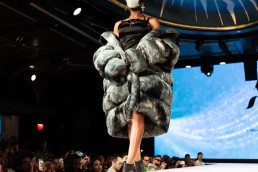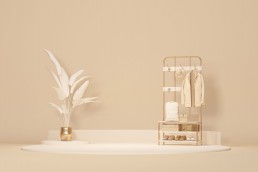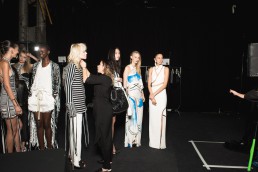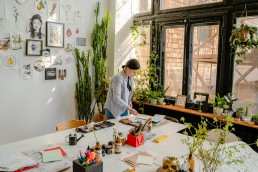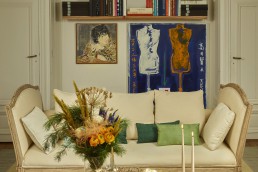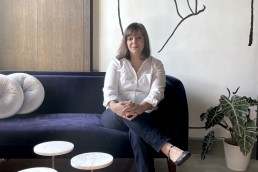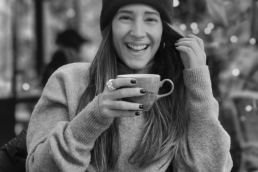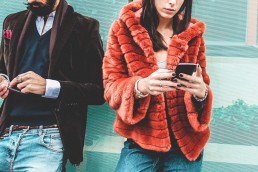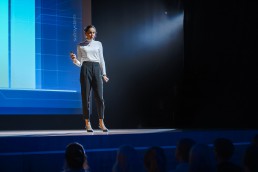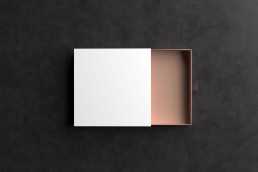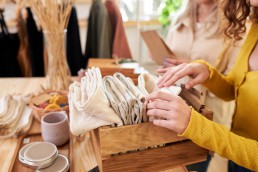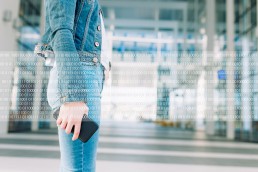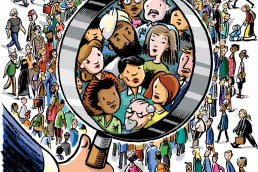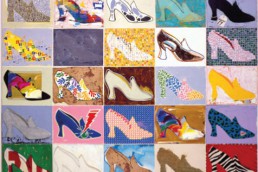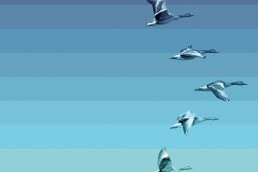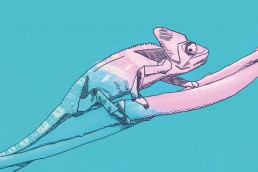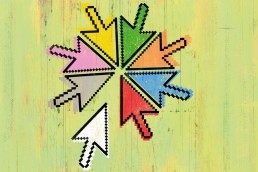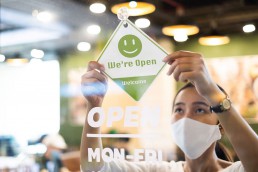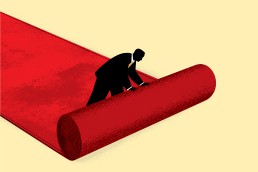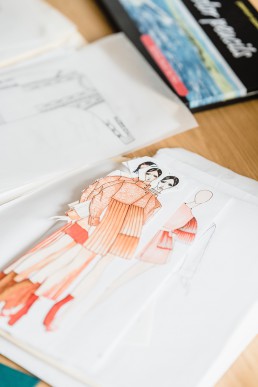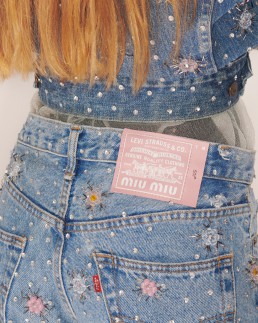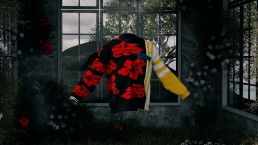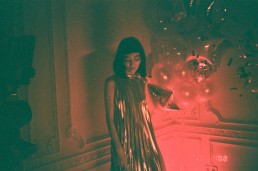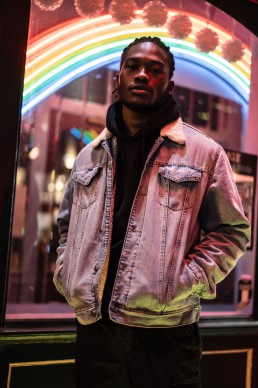Fashion & Hospitality: Why Do Brands Have Experiential Spaces?
From fashion flagships to luxury hotels accommodations, to enjoying exceptional dining spaces or being amazed by monumental art and installations; those are some of the many experiences today brands offer to their clientele. Is “the ultimate experience” the new luxury?
Branded experiential spaces are lifestyle extensions of some fashion and luxury brands. These spaces seek to capture the customer’s attention to engage them in a rewarding, different, and undoubtedly, memorable experience.
Brand spaces can have different formats, either as spaces intended for mere enjoyment and relaxation, a flagship store where the commercial activity takes place or at its opposite pole, non-commercial spaces intended to connect with historical, narrative, artistic elements, or any other discipline close to the core values and the brand purpose.
The positioning of a brand is measured largely by the perception that users have of it. What are the elements inside the brand that they value the most? What do they think of it? And what are the main attributes related to the brand? The creation of brand experiences allows the target audience to interact directly and tangibly within the brand’s world.
This contact instigates us to enter deeply and experientially into everything that the brand has communicated previously in its advertising campaigns, its product offerings, and its ultimate idea of personality and storytelling.
Fashion Venturing Into Hospitality: The Brand Extension Strategy
According to marketing authors Aaker and Kelly, the brand extensions are fundamentally lucrative for any fashion brand, even more so for luxury brands. It is a strategic move “because they provide a way to take advantage of brand name recognition and image to enter new markets”.
This business operation could also be described as diversification of the brand, by joint venture or by a license agreement. Two different, but still complementary, paths for a brand extension strategy include vertical integration, and moving into an unrelated diversification.With vertical integration, brands launch new lines of products inside the company. With unrelated diversification, a fashion brand moves into a completely unrelated area of the business. Fashion and luxury hospitality seek to achieve the same goals, as both industries aim to fulfill extraordinary experiences, create top customer satisfaction, and have one-of-a-kind destinations.Their partnership is a logical move inside the lifestyle business as their spaces provide a sophisticated immersion that clothes cannot have on their own.
We can find several examples of fashion-luxury joint ventures offering dreamy accommodations and a total experience. Palazzo Versace in Dubai and in the Gold Coast of Australia is a privileged destination to live the Versace lifestyle: spectacular architecture and opulence décor.
Armani Hotel Milano promises a “home-away-from-home” experience, delivering luxurious comfort and the lifestyle philosophy of Giorgio Armani’s design. This is the second hotel launched within the Armani Hotels & Resorts project, marking the continued collaboration with Emaar Properties PJSC, one of the world’s most valuable real estate development companies, with experience in shopping malls and leisure.
Round Hill Hotel and Villas, in Jamaica, is the favorite destination for Fashion Designer Ralph Lauren, as he owns a private villa on the Round Hill State. The Ralph Lauren style has been influential in the classic aesthetics across the one-of-a-kind Jamaican property. Located in the Pineapple House, there are 36 Ralph Lauren-designed oceanfront rooms that evoke a classic quintessential Caribbean style. Whitestone floors, signature mahogany beds, and luxurious furniture from Ralph Lauren’s Home Collection make the stay a cinematic experience.
The Bvlgari Hotels and Resorts are selected properties in major cosmopolitan cities such as London, Bali, Dubai, Shanghai, Roma, Miami, and more. The Bvlgari brand aims to be “the leading luxury hospitality collection in the world” with its timeless glamour and honoring the heritage of Greek founder and Jeweler, Sotirio Bulgari. The joint venture is managed by hospitality experts Marriott International and Ritz-Carlton. The Italian architectural firm, Antonio Citterio Patricia Viel is in charge of all hotel properties and restorations.
Many other ventures are worth knowing, such as La Maison Champs Elysees Hotel, under the artistic direction of the Maison Martin Margiela. The Hotel Missoni in Kuwait and Edinburgh, or Casa Camper in Barcelona and Berlin.
In a world where the experience of everyday life has suffered limitations, the luxury hospitality and the tourism sector want to reconnect with those luxury travelers, avid for sensations and unique perspectives.
Fernando Aguileta de la Garza(ELLE BUSINESS)
5 Set Designers Working in Fashion Worth Knowing
The goal of a set designer is to create breathtaking environments using production design techniques. A creative job at the intersection of arts and crafts, illusion, that requires a wild imagination.
Inside the creative industries, the role of a set designer is crucial for advertising campaigns, filmmaking, and ephemeral events. Their skills are related to architecture, space design tools, and developing an original concept for each project.
Set designers are well-known for their work on films and television series, capturing the essence of the scripts and characters to recreate the desired environments and spaces that the film or play requires.
The fashion industry is another field for developing space design projects. Fashion communication tools such as fashion editorials, photography, catwalks, and presentations require the expertise of these professionals.
The set designer’s contribution is to supervise “the look” of a motion picture, a photography session, or the general stage in which an action will take place. They create cohesive pictorial schemes that directly support the fashion concept of a brand or an event.
Professional set designers must create a mood and atmosphere through props – such as furniture, decorations, or one-of-a-kind objects- and a color palette in tune with the clothing. Finally, they must offer creative possibilities to trace the movements for models, actors, or any person involved in the “happening”.
The tools that a set designer uses to communicate with producers, art directors, or other designers are:
-Sketches for ideas and creative research with mood boards and references.
-Floor plans with specific information and an accurate layout for the set.
-Set elevations and 3D renders to view different elements from multiple perspectives.
World-Renowned Set Designers Working in the Fashion Industry
Rem Koolhaas
Dutch (superstar) Architect, Rem Koolhaas is the head behind the Office of Metropolitan Architecture (OMA/AMO) research, and design studio, that “applies architectural thinking to domains beyond”. OMA has worked with Universal Studios, Amsterdam’s Schiphol airport, Heineken, Ikea, Harvard University, and the Hermitage. The long-life relationship with the Italian luxury brand Prada is one of its milestones. This collaboration is credited for the “epicenter’s effect” inside the retail industry. OMA is known to have collaborated hand-to-hand with Miuccia Prada on the set design of her catwalks for more than a decade.
Alexandre de Betak
The “King Midas” of fashion events and fashion show scenography, Alexandre de Betak is the founder of Bureau Betak, a production studio for runway shows, installations, and exhibitions running for more than 25 years. He produced his first fashion show at the age of nineteen in Madrid for the Fashion Designer Sybilla Sorondo. At present, he stages and produces practically every fashion show during fashion week, from Kenzo to Chloé, Fendi, Isabel Marant, Christian Dior, and Saint Laurent among many -many- others.
Shona Heath
Graduated from the University of Brighton, Heath’s work has been linked to fashion photographer Tim Walker, together as a creative couple, they have created some of the most memorable fashion images of all time. She regularly creates sets for British magazines, as well as advertising campaigns for a long list of luxury brands including Louis Vuitton, Miu Miu, Hermès, Lanvin, and Marni. Her signature fantastical approach to sets stands by her reputation.
Stefan Beckman
Beckman is a longtime collaborator of Marc Jacobs, creating his runway presentations. He combines set design work with editorial shoots, and films. Beckman, started in Los Angeles, as a prop designer for art departments in television networks. In the 1990s, he met Art Director, Fabien Baron, starting a creative relationship that stands until today. The studio works across a wide range of projects and exhibitions, some of its clients include Balenciaga, Bottega Veneta, Chanel, or Zara.
Emma Roach
Emma Roach Studio is a London-based design studio specializing in set design, installation, and prop making for the fashion industry. The studio works across a variety of different mediums including film, digital, and print. Roach,who studied sculpture and painting, combines cinematic inspirations and music to create incredible atmospheres. She has worked for Raf Simons, Celine, Fenty, and Jil Sander.
The work of a set designer consists of being immersed in creative concepts, visions, and carefully crafted aesthetics to create amazing projects in fashion. You should be following the best.
Fernando Aguileta de la Garza(ELLE BUSINESS)
What Exactly Is an Upcycling Collection and Why Are Brands Doing It?
Today, we share key aspects of the upcycling movement in the fashion Industry and analyze why more brands are joining this creation method.
Upcycling is more than a buzzword, it promotes a new way of thinking on how and why we should start any design process. Sustainable practices and environmental concerns are on almost every design studio’s agenda around the world, as many designers understand its active role in changing the way fashion is currently made.
In this context, can upcycling be the same term as recycling? Or is upcycling related to second-hand clothing practices only? To answer both questions, we must start by clarifying some terminology in order to be accurate.
Upcycling and Recycling: A Reborn Design and Technical Innovation
The term “upcycling” was coined in 1994 by German engineer Reiner Pliz. a.Recycling at the time diminished the value of old or used products, so he suggested new value must be added instead, leading to the aforementioned term of “upcycling”. Author Gunter Pauli wrote the first published book on upcycling in the year 1998, however, Cradle to Cradle: Remaking the Way We Make Things, by authors William McDonough and Michael Braungart, was the first to gain mainstream recognition in 2002 , that is when the public started to be familiar with this terms and its purpose.
According to Vadicherla et al. on Textiles and Clothing Sustainability Journal: Recycled and Upcycled Textiles and Fashion, “upcycling creates something new and better from the old or used or disposed items” it is a process that requires a blend of factors such as, “environmental awareness, creativity, innovation, and hard work”. In this perspective, upcycling “aims at the development of products [that are] truly sustainable, affordable, innovative and creative.”
There is a similarity with recycling since fibers or products can be processed to get back to their original form after the technical steps, however, upcycling is related to the design process rather than just technical innovation (although it can include both). For example, textile waste can be recycled into new yarns, such as nylon or any other synthetic fibers, because its composition makes the process easier, nevertheless, we can upcycle garments into new designs without processing the raw material at all.
Re-Thinking and Re-Designing: Upcycling as a Creative Challenge
Several fashion brands are making attempts to integrate technical innovations and recycling fibers into the design process. For other brands, upcycling practices are rooted inside their DNA, creating distinguished and recognizable mix-match aesthetics, as some upcycling practices blend opposite garment structures, textures, colors, and shapes, as well as, second-hand clothing and textile techniques.
Big fashion names are opting for innovation, creating singular approaches to eco-design without being less fashion-forward. For example, designer Miuccia Prada with her fashion brand Miu Miu constantly seeks new ways to connect with the current times, Upcycled by Miu Miu is a project that continues to pursue a sustainable ideology, giving new life to pre-loved denim in collaboration with iconic denim brand Levi’s. A selection of classic denim pieces has been re-fashioned by Miu Miu, seen through the brand’s maverick and determinedly playful eye.
This is an interesting strategy combining both brand’s reputations and their shared values whilst celebrating iconic garments, such as jeans and trucker jackets from the 1980s and 1990s, and creating something new and unique, as no two pieces in the collection are the same.
The vintage denim is hand-embellished with crystal, pearl, floral, and all-over diamanté embroideries, puffed sleeves, and bold leather patches featuring Art Deco-inspired intarsia motifs; jeans are cut off to the thigh or finished with ivory silk duchesse turn-ups; and Trucker Jackets are adorned with oversized white lace collars.
This collection is a valuable example that dares to change the creative perspective and invites us to work with remnants of vintage materials or fabrics. The goal of upcycling is that any previous design can surely shine again.
Brands such as Andrea Crews, Marine Serre, Bode, Patrick McDowell, and Christoph Rumpf are well-known names around the upcycling practice, integrating new design possibilities and aesthetics that set an example for the designers of the future.
Fernando Aguileta de la Garza(Elle Business)
How Can 3D Fashion Design Be Applied to Fashion Communications Strategies?
Digital design has been a source of endless possibilities for the creation of innovative assets to communicate fashion collections. Today we share relevant examples and useful ideas you can use for your fashion marketing strategy.
The fashion 3D design revolution is playing an important part in technology development for the creation of virtual garments and avatar characters featuring the latest fashions.
As we stated before in Digital Fashion Designer: 3D Disruption in Fashion and the Design of the Future, the fashion designer will be dealing with high-level hybridizations between the physical world and the digital world, transforming-and innovating- the design, and of course, fashion’s communication processes.
If we create virtual clothing as an alternative way to showcase our fashion collections, it is important to think about the digital strategy of it, as well as what the communication concept behind that particular collection is.
The integration of social media channels, such as Instagram, TikTok, and YouTube, as the brand’s main communication touchpoints allows any project to directly connect with its community, creating attractive videos and photo layouts to portrait the essence of the brand.
In that sense, including and creating 3D assets for fashion campaigns, brings the edgiest point of view for the collection, and definitely a very high technical standard in terms of new fashion communication ideas.
Virtual Runways and Presentations in Fashion Communications
Due to the restrictions of the pandemic, many fashion brands began to digitize their marketing and communication actions, focusing on audiovisual, fashion’s “star format”.
However, with the possibilities offered by 3D design software, there is a strong trend in producing entirely digital fashion shows with virtual avatars, the leading characters wearing the fashion collections created entirely in a computer.
It is a very experimental and avant-garde format, which some brands are introducing into their communication strategy. The Italian ready-to-wear brand Sunnei, for example, is a reference for this trend. With the Canvas collection, both SS21 and SS22 seasons have created a universe full of virtual models that dress, transform, and change clothes thanks to the digital software which allows a 360 degree view and thus the option to see the garments from different viewing angles.
Their signature pieces in plain white serve as the basis for customization sold exclusively through a virtual platform. “3D practice is the chosen medium for both the development of the collection and the creation of animated avatars that will guide the ultimate translation of the brand’s lexicon”, the brand stated during the project’s launch.
Founders Loris Messina and Simone Rizzo have found a balance between new formats such as digitalization, virtual reality, and classic physical presentations in the fashion week schedule.
Special Fashion Communications Projects and Capsule Collections With 3D Garments
Digital garments give us the possibility to alter the large cycles of fashion design and sample-making. Thanks to 3D tools, small collections can be created virtually and sold through e-commerce platforms.
When we produce communication actions in 3D, not only do we save time in modifying and editing the final garments, but the processes of photography and campaign concept are simplified, as digital makes it a more agile and time-sensitive action.
For example, Prada Timecapsule is a special project inside the Prada brand, merging technology, signature design, and exclusivity. The “drop” presents a limited-edition bowling shirt for men and women on the first Thursday of every month, an online exclusive item available for only 24 hours. Animated by one-of-a-kind colorful prints, the cotton poplin designs feature a distinctive logo, together with a serial number and sophisticated dedicated packaging, making each one unique.
The Timecapsule section is now available in Europe, as well as Japan, China, USA, Canada, Singapore. The project will reach other markets over the course of 2021, as it refreshes monthly with new designs, with a communication campaign based on 3D video graphics, and the possibility of showing different perspectives of the garment.
This project represents a fashion-forward campaign integrating the best of 3D technology, new communication formats, and the “Pradaness” view on design.
Retail Windows and Fashion Advertising Campaigns
For example, Nike, a sports-meets-technology pioneer brand, launched a sneakers campaign with brand activations in different points of sale using 3D technology. In some cases, this campaign was carried out on advertising displays in Amsterdam’s streets, inside retail stores, and bus stops thanks to Holocube technology. The Holocube is a 3D projection platform that makes a virtual simile of any product with an amazing resolution capacity. The projection can be seen through a window which provides a powerful and eye-catching 3D effect.
New formats are emerging inside the fashion communication landscape, as technology is driving change and innovation inside the fashion industry.
Fernando Aguileta de la Garza(ELLE Business)
From Hacking Brands to Fake Runways- Fashion’s Communication Strategies Take On Digital
If you want to learn more about the latest fashion communication actions read this article to find out what luxury and streetwear brands are doing this season to keep up with fashion.
Fashion communications is a vast field for innovation and the development of new experimental tools to engage audiences worldwide. A closed communication strategy is no longer in fashion, as digital channels provide a wider possibility to make international digital events, and clients can start social media conversations around the brand’s latest collection immediately after launching.
In a world where full pandemic recovery has not yet been achieved, the fashion industry is making hybrid attempts to do things differently, creating experiences between digitalization and physical gatherings to provide a fresh message, avoiding “business as usual” fashion communications.
If you have a small brand or project, you can find inspiration for your fashion communication strategy in this article besides analyzing the most creative actions of this season so far.
Dear Creative Director, I Am Going to Hack Your Brand
Forget about collaborations as the ultimate fashion strategy. This season, Gucci Creative Director Alessandro Michele, did a “hacking” creative exercise with high fashion brand Balenciaga, with the total approval of his Creative Designer Demna Gvasalia. The result was a mashup of silhouettes, logos, and iconic pieces from both fashion houses, a parade inside a video film where the main objective was the celebration of Gucci’s 100th anniversary and a tribute to his founder Guccio Gucci. The mix of heritage with provocative and a peacock outsider aesthetic has been the trademark of Michele’s conceptualization for the Florentine brand. Gucci Aria (Air) has 7.4M page views on YouTube with a “hacking lab made of incursions and metamorphoses”. For Michele, Aria meant “a deep and ecstatic diving in everything we yearningly miss today…a jubilee of breath”. For creative inspiration, beware the fashion hackers.
The Battle of Fake Runways Versus Magnanimous Fashion Events
Fashion communication events have been split between two main categories: the return of over-the-top presentations, and the no-audience pre-recorded runways. Resort collections took the lead selecting spectacular locations to host the event. Louis Vuitton filmed a runway at Axe Majeur, an architectural masterpiece near Pariscreated by the Israeli artist Dani Karavan and Spanish architect Ricardo Bofill. The Dior Cruise show took place at the Panathenaic Stadium, an icon in Greek culture and cult place for the Olympics. On the other hand, “fake runways” are trending; a format championed by Balenciaga, Y/Project, or Hermès Paris, to name a few.
From Europe With Love: Books, and Postcards for Waking-up Your Imagination
The physical materials, or at least its aesthetic evocation are still in fashion, as well as traveling as a source for inspiration. Belgian designer Dries Van Noten presented “Greetings from Antwerp ”, a video shooting showcase portraying key places around the city. In addition, he created social media “postcards” as a campaign image. Loewe’s Jonathan Anderson presented a box containing a slipcase with two books, four posters featuring artwork by Florian Krewer, David Sims photography, and the look book images for men’s and women’s collections. For Anderson, “Party in a Box” message was an “electrifying escapism of hope and optimism” .
Video Art Narratives, Look Books, and Fashion Gifs
Video Art and Fashion Film are still in the Top 5 of fashion communication actions. Prada’s latest collection was filmed in Milan at the Fondazione Prada’s Deposito, the show represents a transition between a tunnel, an urban atmosphere, to end in the Sardinia’s Sea, a natural one. “An uncanny summer escape, concluding in a space where nature and artifact interact”, according to the brand, in a stunning set design by OMA. British designer Richard Quinn presented an opulent video art story showcasing an outstanding fashion narrative, his aesthetic codes, and impressive music soundtrack starring Underworld’s Born Slippy, and Diana Summer’s I Feel Love. On the other hand, Balmain’s animated gifs proposed a hybrid between animation and still photography.
Billboard Fashion, a New York’s Original
Marc Jacobs is back in the game with a fashion runway held under the grand arches of the New York Public Library. The designer teamed up with Bergdorf Goodman, another New York fashion institution, to broadcast and project the show on the building’s façade. “Our exclusive partnership with Bergdorf’s will allow us to offer our customer an unparalleled qualitative approach to owning the runway”, a brand statement on the show notes. Jacobs presented an intimate yet powerful fashion presentation. “Happiness”-the show’s title-, is a journey back to creativity and transcendent moments of joy, “through the physicality of this shared experience, I hope to offer a moment of inspiration, curiosity, wonder, and possibility”, stated Marc Jacobs.
Innovation, original ideas, and creative experimentation are the “new normal” in fashion communication strategies, as season after season, fashion designers still dare to think outside of the box.
Fernando Aguileta de la Garza(ELLE Business)
What is an NFT, and Why Are the Fashion and Luxury Industries Betting on It?
You have probably heard about cryptocurrencies, digital fashion collections, or digital artwork being somehow related to the popular term Non-Fungible Tokens (NFTs). Why is everybody talking about it, and what exactly does NFT mean?
Last March, NFT artwork released by the artist Mike Winkelmann, a.k.a. Beeple, was sold for $69M in an auction at Christie’s. It was a tipping point for the explosion and fever around NFTs, which has now found its way into fashion and luxury. Will that change the game, or is it too soon to speak?
First of all, NFTs are digital assets linked to a blockchain database, in a similar way to cryptocurrencies Bitcoin or Ethereum, for example. However, what sets them apart from the cryptocurrencies, is their uniqueness, and the quality of being irreplaceable or unexchangeable.
A cryptocurrency works the same way as traditional money, it is fungible, which means you can trade it for the same amount, number, or equivalent. When we deal with an NFT, that is not possible, due to its “one-of-a-kind” characteristic. The rareness and scarcity are positive qualities of an NFT as an intangible digital asset, however it can be bought and sold like art or other tangible objects.
NFTs can multiply and take the form of many digital artworks such as GIFs, tweets, images, video content, digital clothing, drawings, and animations, to name a few. As it only exists in digital spaces, we are not exactly buying the piece itself nor the copyright.
What Exactly Are We Buying in A NFT World?
As a digital item, shareable and storable by everyone on the Internet, the general public started to question the utility of buying something that individuals can download from their computers.
This is the tricky part, because what we are actually buying is the token value, such as the original serial code for that particular NFT piece. The acquisition is guaranteed by a digital certificate of ownership, so no matter if there are plenty of copies all over the Internet, that code proves its “original” source and provenance through blockchain.
Several examples of NFTs auctions are featured in worldwide media in a mix of skepticism, sky-high prices, and confusing terms. Last January, the “Disaster Girl” meme, sold for 180 Ethereum, valued at $500,000 Zoë Roth (now a young woman), told the New York Times she will use the money to pay student loans and for charity purposes. In March, the user Sina Estavi was the winning bidder for Jack Dorsey’s (developer and Twitter CEO) first-ever tweet, for $2,9M.
Musician and artist Grimes did a similar move, auctioning a collection of digital artworks for $6M including video pieces. Music band Kings of Leon have generated $2M in sales of their latest album NFT When You See Yourself.
The market is rising, especially in the art world, and auction institutions such as Sotheby’s have presented this June Natively Digital: A Curated NFT Sale featuring NFT Artworks by Ryoji Ikeda, Pak, Don Diablo, and Mario Klingemann. The online auction was co-curated by Sotheby’s and leading crypto artist Robert Alice.
Furthermore, the sale introduced a new category of NFTs: the intelligent NFT or iNFT, a collaboration with cutting-edge AI company Alethea AI. Alice is the first truly intelligent, conversive, self-learning artwork that lives in cyberspace sold for $478,800.
The global sale soared to $17.1M attracting new buyersto Sotheby’s accounting for nearly 70% of sales, and more than 1,300 bids across the sale. Alien #7523 CryptoPunk NFT, was sold for $11.8M creating a new world auction record for a single CryptoPunk, one of the most coveted and recognizable works of digital art coming out of the NFT movement.
Are NFTs Now in Fashion, or Not?
As Internet speed is faster than fashion, it was a matter of time that fashion brands and the world of art started to test and experiment with the NFT phenomena. Both, the fashion and the art world are the masters of the tangible, oracles of what is worthy and valuable.
It is a logical move for them to be the first to jump in, as their market could suffer from this new perspective and lead to unprecedented movements. However, do not bet so fast.
This month Gucci sold NFT Aria at Christie’s Proof of Sovereignty‘ sale, curated by anonymous digital artist Lady PheOnix, and art specialist Noah Davis, for only $25,000. The NFT was inspired by the latest fashion film co-directed by Creative Director Alessandro Michele, and award-winning Photographer and Director Floria Sigismondi.
In this context, the amount is a debatable success, considering that a crocodile Jackie 1961 bag from the brand is worth 20,000€, or that a ready-to-wear silk dress may be sold for 16,000€. On one hand, Gucci is pioneering new technologies and innovative forms to communicate fashion, as they did with the sold-out 12€ virtual sneakers. On the other hand, maybe the market is not ready yet or we are in the process of imagining the future.
The road is still a long journey, as the main focus is NFTs related to 3D garments that have a limited utility inside the virtual world, and not yet into the mainstream. Save your bets because this is not over.
Fernando Aguileta de la Garza
5 Tips to Create a Powerful Styling Concept for a Brand
Brand styling has become a valuable tool to create a perfect brand image in online environments. Today we share useful tips to create a sophisticated styling concept for a brand.
Brand image and brand styling are useful tools to communicate our brand identity, reach new audiences, and get possible new clients. Any business, or design project, can develop an image strategy that reflects a certain type of atmosphere to connect with the personal desires and tastes of their clientele.
Emotional connection through images and sensations is mandatory to develop a long-term relationship with customers. When we build a brand, we do not only consider the product characteristics, we try to create a visual story to go along with it.
The dynamic between product and storytelling is supported by a physical brand design that can be reflected in catalogs, website layouts, look books, corporate identity, advertising campaigns, and social selling promotions to name a few.
Whether you are developing a branding project or an image consulting project, below you will find valuable knowledge and smart tips to grow your project, furthering your understanding of the importance of brand image and styling.
1. A Brand Stylist Is a Designer and a Strategist at the Same Time
If you want your brand to stand out from the competition, you must develop an authentic visual proposition for it. However, being visually outstanding is not the only requirement for a successful path. You must think strategically about the brand purpose and its vision; ask yourself what the main values and the top brand’s product attributes are, and, especially for whom we are developing this precise branding image.
Graphic designer’s skills are a must, as you will be in charge of the creation of the brand visuals such as logo, colour palette, proportions, brand icons, or standard graphic brand layouts. You have to be visually creative, taking all the brand’s hard information and turning it into a visual reality. Design software such as Photoshop and Illustrator are essential design tools. Also, online tools and apps, such as Canva, can be of great help to beginners.
2. Match Your Brand With a Perfect Look and Feel
To start, you should research a lot on the soft areas of the brand to understand its essence and personality. With that in mind, we must collect visual inspiration images such as photographs, textures, forms, typographies, proportions. We can create our own image too and mix-match with the inspirations to build the brand’s mood board. Then, we can edit its final version.
The term “look and feel”, covers a wide range of aspects applied to a brand, as it has to resonate emotionally with the customer in order to make them feel attracted to it. If we define our “look and feel”, a certain type of decisions would be easier to make such as casting, model’s attitude in a photograph, graphic balance, and aesthetics. When we find our “vibe” we will have found our treasure.
3. When You Style a Brand You Must Think as a Creative Director
Creative direction rules every visual aspect of a brand, sometimes including the product and the visuals attached to it. Also, a brand stylist can be involved into the communication strategy, as their role can be useful to “activate” the brand’s aesthetic in a powerful way.
For example, think about developing creative campaigns and creating an emotional claim; those aspects are part of the job. If we integrate all communication aspects, in the end, we are going to deliver a consistent message and a sophisticated curated image to support our brand goals.
4. Define a Visual Tone and Keep It for the Long Run
If you are tempted to radically change a brand’s image, think it through. Rebranding is a necessary part of a brand’s aesthetic evolution, however, it must be created for the long run. If we style a brand and define its visual tone and visual expressions, we must be consistent
5. Being Instantly Recognizable Is Brand Value in Action
If the brand aesthetic and the styling concept are well received by the target, our job is done. A powerful image can build brand awareness and loyalty, as the customer will feel connected to the brand’s visual representation. A recognizable brand image can increase our brand value and strengthen our brand positioning.
Creating a brand styling and building its visual identity are one of the most challenging and creative stimulating parts of branding, and a great area to unleash our creativity.
Fernando Aguileta de la Garza
Outdoors Design: How Yayoi Kusama Is Taking Over New York's Botanical Garden
The KUSAMA: Cosmic Nature exhibition features new sculptures and the famous mirrored environments created by the celebrated Japanese artist, combining Art and Landscaping.
Yayoi Kusama (Matsumoto, Nagano, Japan) is one of the most well-known female living artists in the world. Her signature polka dot artwork made her instantly recognizable. Kusama’s installations and paintings possess an immersive quality, the artist wants us to explore her obsessions, reflections, and repetitions happening in her mind.
The exhibition presents the artist’s lifelong fascination with the natural world, as the art installations merge and interact with The New York Botanical Garden (NYBG); a one-of-a-kind opportunity to witness and explore that kind of display.
Kusama’s works suggest the patterns that we can observe all around us, a metaphor for being part of something bigger, connected to the essence of life. The exhibition is installed across the 250-acre Botanical Garden’s landscape, in and around the Enid A. Haupt Conservatory, and in the LuEsther T. Mertz Library Building including seasonal horticultural displays.
Formerly postponed in 2020 due to COVID-19 restrictions, the exhibit evolves into four experiences that focus on Kusama’s relationship with greenhouses and the fields of her family, regressing back to her childhood, her family had a plant nursery and were seed farm owners.
Founded in 1891, The NYBG is the most comprehensive botanical garden in the world; its conservatory supports a living collection of more than one million plants and eleven million archival items in its botanical and horticultural library. They will be hosting the exposition until October 31, 2021.
Yayoi Kusama, Art, and Aesthetics as a Design Inspiration
The role of Kusama’s art as a design inspiration is well extended from fashion to furniture, and visual aesthetics. Through the years this Japanese artist has created a powerful artistic dialogue about taboo topics such as, mental illness, vivid hallucinations (where she extracted her “infinity nets”), or what she calls “self-obliteration”, as the form to express to the world what is happening inside of her mind.
It is mesmerizing how some of Kusama’s creations, mostly related to death or paranoia, find a new light into the garden’s setting as the multiple outdoor installations, including monumental sculptures of flora, and her signature polka-dotted organic forms can be surrounded by life at its best.
This vivid observation of nature, completely appropriate for the current times, brings some of her earliest works into the public eye, and some of them are presented for the first time in the United States.
“For Kusama, cosmic nature is a life force that integrates the terrestrial and celestial orders of the universe from both the micro and macrocosmic perspectives she investigates in her practice. Her explorations evoke meanings that are both personal and universal” stated guest curator, Mika Yoshitake as she considers nature, not only as her inspiration but also integral to the visceral effects in Kusama’s artistic language.
The show is organized between the gardens, inside of the galleries, and in the library, where the visitor can find examples of her botanical drawings, works on paper, biomorphic collages, assemblage boxes, sculptures, and paintings. Any outdoors and exterior design lover will be amazed by the curator’s work.
Inside the exhibition, her world is alive. I Want To Fly to the Universe, is a 13-foot-high bright purple-tentacled anthropometric floral form in the reflecting pool by the visitor’s center. Also, the monumental Dancing Pumpkin, a 16-foot-high bronze sculpture, painted in black and yellow, is sited in an immersive landscape of river birches, flowering plants, and grasses.
Her famous Ascension of Polka Dots on the Trees, in vibrant red and white polka dots, soaring in the trees, and Narcissus Garden, a 1,400 stainless steel spheres floating on the water’s surface creating a captivating effect, mirroring the entire environment and changing as the wind does, have an important presence in the exteriors.
The Infinity Mirrored Room- Illusion Inside the Heart, will operate with protocols and guidelines for social distancing and visitor safety for interior access to begin this summer.
The pink-and-gold mosaic Starry Pumpkin is featured in a woodland garden of foliage and flowers have been chosen to harmonize with the sculpture’s pink polka dots. The NYBG horticulturists have designed a “living work of art” effect, using Kusama’s painting Alone, Buried in a Flower Garden as inspiration. They want to mimic the painting’s bold shapes and colors, with plantings changed seasonally. A great dynamic and example of how to bring art in the outdoors and to use landscaping techniques.
“Dancing through our universe are noble souls whose magnificent forms are saturated with mystery” stated Yayoi Kusama, in an invitation to the public to explore the “beauty of love that is [her] art”.
At the intersection of art, landscape design, nature, and the cosmos, KUSAMA: Cosmic Nature exhibition is for sure a once-in-a-lifetime presentation that will continue inspiring an entire generation.
Fernando Aguileta de la Garza
Creative Problem Solving to Redesign Your Business with a Purpose
Leaders must find ways to maximize the current opportunity. At the time we are in the so-called VUCA times (Volatility, Uncertainty, Complexity and Ambiguity), and these moments require different ways to approach problems.
That exactly is what Creative Problem Solving (CPS) tool kits and methods have to offer to leaders and their teams. Novelty, innovation, and disruption are seeked out by almost every single leader when thinking about their business, products or services. As of now you have probably been in at least one design thinking session, and during the last year you have also probably upgraded the physical post-its into a digital board. What you might not know is that this process is only one of many possible roads in the map of CPS.
“Is it possible to redesign a business and revisit or build a purpose one post-it at a time?” The answer has deeper roots than “yes” or “no”, that is why I interviewed Matthew Manos, Founder of Verynice, a collaborative design strategy practice that specializes in Creative Problem Solving, and Editor-in-Chief of Reginald, a library of pay-what-you-want creative problem solving tool kits.
When asked to define the concept, Matthew said that: “The most typical definition of ‘Creative Problem Solving’ is the creation of an entirely novel solution to a problem; an idea that no one has come to before. Some of the most popular methods in the space include participatory design or co-design (designing a solution in collaboration with your end user, as opposed to just with a team of “experts”), design thinking (empathizing with the end user, defining the problem, ideating, prototyping, and testing), and the traditional creative problem solving method (clarifying the problem or need, ideating solutions, developing an idea, and implementing it). So, Creative Problem Solving is often associated with the end result of a creative pursuit; it tends to assume a solution is always what we’re working toward”.
However, for him it is more about the process than the solution itself, in his words, it “is about developing unique and unconventional processes that may lead to appropriate (not necessarily innovative) “solutions”, but can also focus efforts on gaining a better definition and understanding of what the “problem” itself is”.
How to Pivot and Find Purpose Through Creative Problem Solving
We’ve heard a lot about being in “uncertain times” during the last 18 months, but Matthew clarifies that there is no such thing as “certain times”, since the future is impossible to predict, so it is always helpful to foster creative thinking when approaching big and small opportunities to mix things up at a company.
Divergent thinking, one of the pillars of Creative Problem Solving, is about throwing big and even unrealistic ideas that can open up an entirely new way of thinking about the vision of a product or service simply by cultivating a new and unusual perspective.
Regarding the best approach to get started, Matthew recommended asking “why do I need to do so?” in order to have clarity about the problem, instead of jumping too quickly into conclusions on how to improve the business.
One way to do this is through a very popular methodology called “The Five Whys”. This method was created by Sakichi Toyoda to help the Toyota Motor Corporation better understand the root cause of a problem. The way it works is simple, ask “why?” five times. By the fifth answer, you’ll gain more clarity around the problem you are trying to solve.
Once you’ve done this, engage in a brainstorming session with a diverse group of stakeholders from within the organization (staff, leadership), and external stakeholders (customers, vendors, etc.). Work with them to refine your definition of the problem, and to generate ideas.
The Paradox of Choice: Picking the Most Suitable Tool Kit
There are several techniques and tool kits to go through a Creative Problem Solving process. From Matthew’s perspective, when selecting a tool kit or method to use, businesses should consider two things: the culture fit, and the functional fit.
A more playful approach may not fit well within a more traditional environment. And vice versa. Selecting a tool kit based on culture fit is important, as a method with a structure that aligns with the team you’re working with will be more easily adopted. The same thing applies to functionality, depending on the problem the organization wants to solve, one specific tool kit might work better than the other.
“I do believe that one of the best things a company can do is create its own unique approach to Creative Problem Solving. My recommendation is to try all kinds of approaches in order to learn more about how these methods work, then remix them to create your own unique approach that better aligns with the ambitions and culture of your team”, added Manos.
Measurement and ROI
The impact could be measured in two ways: by asking the impact on the problem originally identified or the impact of the process in the mindset of the team. Creative Problem Solving can also lead to a creative culture change. As an example of this, Matthew shared the case of a psychologist named Robert Epstein who, in a study with a group of 74 people, was able to increase the group’s capacity for idea generation by 55% over the course of 8 months by using creative thinking exercises.
Finally he added that “creative work is often hard to measure in a scientific manner. However, one attribute of Creative Problem Solving is it tends to make processes or approaches that may otherwise feel subjective, objective. In doing so, as odd as it might sound, creativity can come closer to feeling like a science”.
María Mercedes Baltazar(ELLE Business)
What Is "Pink-Washing" and How to Avoid It in Your Fashion Marketing Strategy
Social awareness and committed brands are a highlighted perspective for fashion marketing right now. Today we share insights on brand activism without epic fails.
Every June, thousands of brands in all categories start the so-called “pride activation campaign”, the organization’s target: the LGBTQ+ community. The idea is to show them how progressive they are, and how great a logo looks like with a multicolor shade, without actually taking any actions to benefit or move forward LGBTQ+ rights.
This is a classic example of “pink-washing” a coined term to describe this type of mischievous behavior from corporations, countries, or governments trying to project a positive image and friendliness towards the LGBTQ+ community.
These actions are made for the organization to be perceived as inclusive and respectful for diversity and gender orientation, when in fact, the organization has policies in place that show almost the contrary. Sometimes these marketing actions even try to diminish past negative actions or divert attention from them.
A PR effort to clean corporate image is malpractice rooted in transversal sectors and affects the credibility of the organization or the brands involved. You have probably heard similar terms such as “green-washing” -regarding environmental issues with zero real implication in sustainability- or “purple-washing”– regarding visibility of the feminist movement without actions to change and break the “glass ceiling” for example.
“Pink-washing”, also known as “rainbow-washing”, is a problematic path for any brand for two main reasons. First, performing Pride gimmicks for one month a year does not make a company an ally, their false façade will fall sooner or later, as their intentions are not based on shared values. Second, using a minority group to profit without really getting involved in their reality, concerns, needs, and actual lifestyle, is unfair as it is only seen as a mere consumption market.
That capitalist agenda linked to the pride marches is the complete opposite of what The Stonewall Riots in 1969 meant, which was leading to the modern US gay rights movement. Pride is not supposed to be a party or a market celebration that companies can profit from. It certainly is a commitment to inclusion, authentic values, and being part of the global civil rights conversation.
Brand Activism: Create a Strategy Around a Social Issue, and Mean It
Brand strategists and fashion marketing experts need to integrate brand purpose with tangible actions to pursue brand awareness beyond profit. Activism in this context is not only about brand positioning, but a means to build brand loyalty; it is also about making a statement and fulfilling it, as customers, now more than ever, want their brands to be politically involved,eco-friendly, and to create a safe work environment for all.
Brand activism is related to the new business paradigms of Corporate Social Responsibility (CRS) and Environmental, Social, and Governance (ESG). The powerful dynamic between these areas is transforming companies, turning them from indifference into proactivity towards achieving justice and an equally fair world. Brand activism has to do with “how progressive businesses are taking stands to create a better world” stated Phillip Kotler and Christian Sakar in their book, Brand Activism: from purpose to action.
People want their brands to advocate for the same values and beliefs they hold, either to be LGBTQ+ supportive, anti-racist, or demand fair work payments. For example, 85% of the average US public would switch consumer brands over their association to a cause, according to a research study by Cone Communications, highlighting the opportunity to empower progressive activism and to communicate it.
Do It Right and Do Not Use the LGBTQ+ Community as a Token in Your Fashion Communication
Fashion has been one of the industries with the most public backlash in the last few years. Mainly due to a systemic opacity towards its activities, a lack of inclusivity in fashion communication campaigns, in addition to deficient communications messages in sensitive topics such as racism, elitism, or biased representations about beauty.
Customers are now completely aware of the power of their wallets. They know every fashion choice involves a political act, and they have learned how to raise their voice thanks to social media channels.
How to Avoid “Pink-washing”?
-Do not believe in hype, believe in purpose: Think about your brand’s core values, how can you match the ideal scenario with the current reality towards social commitments inside the brand?. Everybody talking about purpose does not mean you have to copy the same strategies. Find your authentic route and trace a strategy where honesty is present, as well as, acknowledge that this is a long-run effort. Avoid “corporate pride” and empty gestures, no one is buying it.
-Be inclusive and prove it: You cannot claim you care about diversity and a body-positive image if you portray standardized beauty clichés in your advertising campaigns. This not only has to do with external communication, but also with inside employee policies that guarantee inclusive teams, equal treatment, and visibility in senior management positions. If your brand is committed, it has to create measurable outcomes, a valuable proof of that sincere effort to make all people feel included.
-Connect with organizations that make real actions: As a brand, you cannot do it all, even if you are willing to make a pride fashion collection and donate the revenues, for example, there is another path beyond selling. Find local organizations supporting LGBTQ+ education, health, or social issues and create a long-term partnership with them, brainstorm innovative ideas to match the brand to the cause.
Promoting a social cause is not a trend, and it never will be. Brands must look for authenticity and empathy in their communication strategy. Commitment matters and there is no time left to waste.
Fernando Aguileta de la Garza


